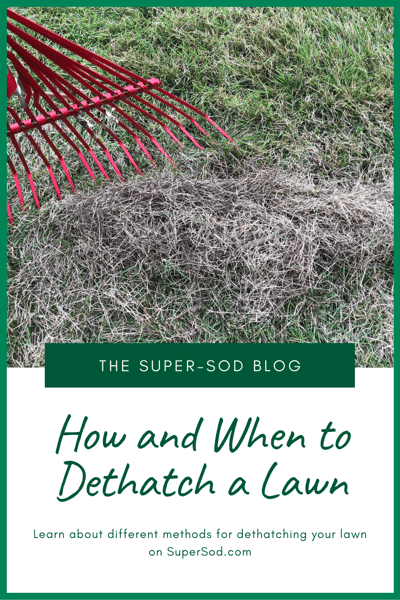
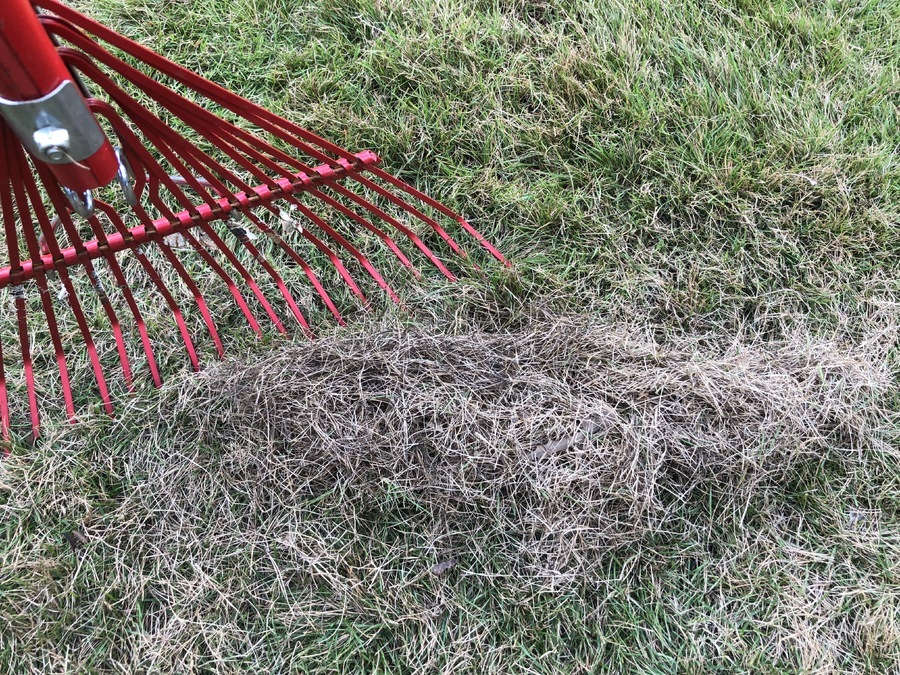
Thatch is a spongy layer of plant debris that accumulates below the leaves in warm-season lawns. It builds up in Bermuda, Zoysia, and Centipede lawns because they grow by “runners” (technically called stolons and rhizomes). The thatch layer consists of living and dead material, both produced by the lawn itself.
Dethatching is the process of removing thatch by mechanical means. It’s not always necessary to dethatch a lawn; some thatch is to be expected and about 1/2 inch of buildup is typical.
If the thatch layer is more than 1/2 inch, your lawn will show signs of struggling due to heavy thatch and you’ll see more brown, dead grass blades amongst the green, living lawn than is desirable. Thatch should be removed when the buildup reaches 1” or more.
We’re going to explain how to prevent thatch, then we'll explain how to dethatch, plus the benefits of doing so.
How to Prevent Thatch from Accumulating
Thankfully, there are easy techniques to incorporate into your lawn care routine to prevent thatch from building up in the first place.
Practice these good landscaping techniques to minimize thatch and you may never have to dethatch your lawn by mechanical means (dethatching is explained further below).
1) Prevent Thatch: Aerate & Topdress with Soil³ Compost
Rent a core aerator to remove plugs of soil/turf from your lawn. The holes left in your lawn are portals for air, water, and compost to seep into and benefit the soil.
After aerating, topdress with Soil³ compost to further improve the growing conditions and reduce thatch.
Microorganisms inherent in our Soil³ compost break down the thatch layer. They consume thatch and turn it into nutrients, thereby benefiting your lawn by improving the health of your soil.
We recommend aerating and topdressing with Soil³ compost once a year, when your lawn is fully green and actively growing.
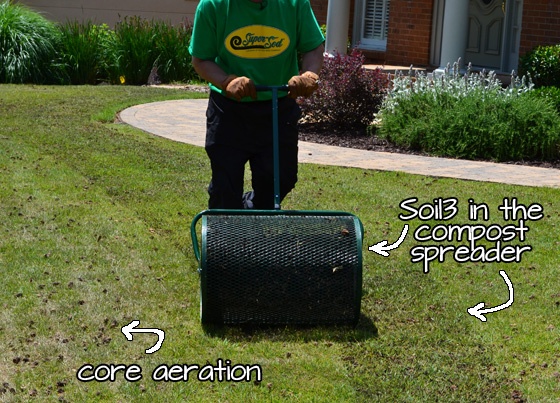
2) Prevent Thatch: Avoid excessive amounts of Nitrogen
That first number on the fertilizer bag is what most people recognize for getting the grass to grow. It’s the 16 in the 16-4-8 ratio. When overusing Nitrogen to push lawn growth unnaturally, it contributes to thatch. Stick to our recommended fertilizer rates for your type of lawn.
3) Prevent Thatch: By Mowing Smart
Yes, that machine in every garage – the lawn mower – is a tool for reducing thatch.
- Establish Consistent Mowing Habits: A frequent and diligent mowing habit is one of the best ways to reduce thatch buildup . . . simply mow on a schedule according to your type of lawn. The reason is that shorter clippings break down quicker, thus reducing thatch accumulation.
- Bag Long Clippings: If you skip a mowing session and the grass gets too tall, then bag your clippings to remove them from the lawn. When you get back on a regular mowing schedule, you can let the shorter clippings stay on the lawn because they’ll decompose faster and won’t contribute to the thatch layer like the long clippings will.
- Let a Robotic Lawn Mower Prevent Thatch for You: Our best tip is to get a robotic lawn mower because they go at it 24/7 (no skipped mowing sessions) thereby cutting minuscule clippings. These tiny little clippings decompose quickly and don’t build up to create thatch like bigger clippings do.
How to Dethatch a Lawn
When your warm-season lawn builds up too much thatch, removing that debris layer becomes necessary. After you dethatch by these mechanical methods, going foward, establish the preventative techniques we explained above.
1) Dethatch by Aerating & Topdressing with Soil³ Compost
Core aeration will not quickly remove thatch, but it is the safest method for the health of your lawn. While topdressing with compost is one of the key prevention techniques, it will also mitigate thatch buildup because the microbes in Soil³ compost will break down the thatch over time.
2) Dethatch by Scalping with Your Mower
Scalping is the term for removing the grass canopy, usually by a lawn mower set at a low cut height.
This is not the preferred method for dethatching, but you will see others scalping dormant Bermudagrass. We've hurt our own lawns scalping them – this procedure is that touchy.
We strongly recommend employing all the other methods we mention, rather than scalping.
- If you scalp too low, you can kill your Bermuda lawn or severely stunt it, so we don’t recommend this practice.
- Plus, if you do it at the wrong time, you can end up with cold damage.
- We especially discourage it for Zoysiagrass or Centipedegrass, as they don’t recover as well as Bermuda does from the stress of scalping.
This Bermudagrass lawn was intentionally scalped. Now we wait for green growth - will it start growing again? This is a scary time. If you scalp, water like crazy and fertilize to help the stolons sprout new growth.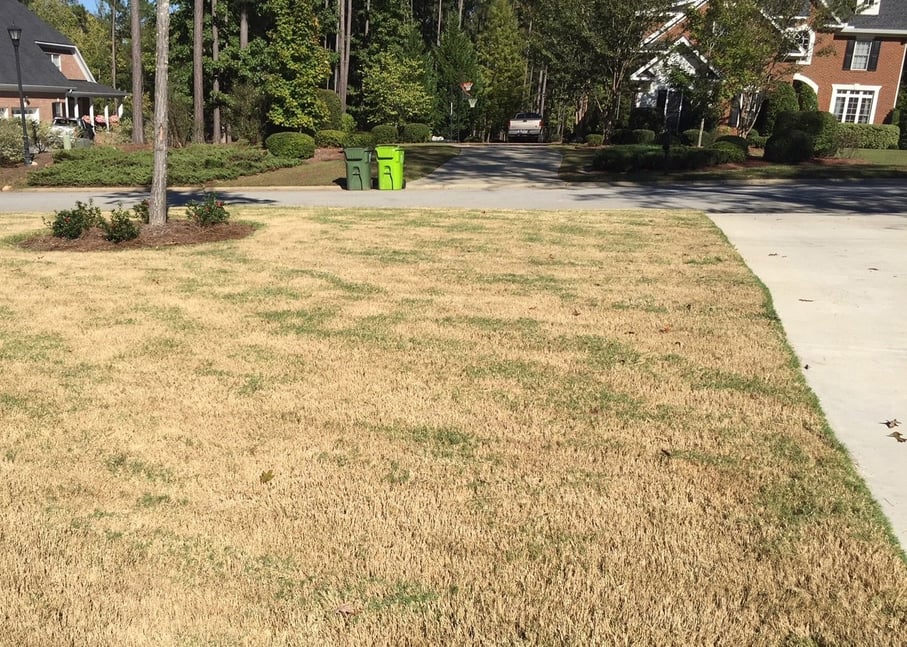
3) Dethatch with a Dethatching Machine or Power Rake
Work the dethatching machine over your lawn in a crosshatch pattern by going back and forth in one direction (north to south), then back and forth perpendicular to that pattern (east to west). Plant debris will be brought to the top, which you can then blow off your lawn using a leaf blower.
You'll see a lot of thatch flying in this video because we forgot to attach the debris deflector plate. Attach that plate and it's less messy. We have also tried electric dethatchers and they work well too.
4) Dethatch with a Rake
If you have a small lawn, all you need to do is get a leaf rake and rake out that thatch by hand. Like with the machine, you’ll bring a lot of dead plant matter to the top, which you can then blow off your lawn. There are also specific thatch rakes, if you like having specialized tools.
Dethatching with a leaf rake. It's fun! Rake deeply, but avoid tearing up the stolons too much. Then blow the piles of thatchy material off your lawn with a leaf blower.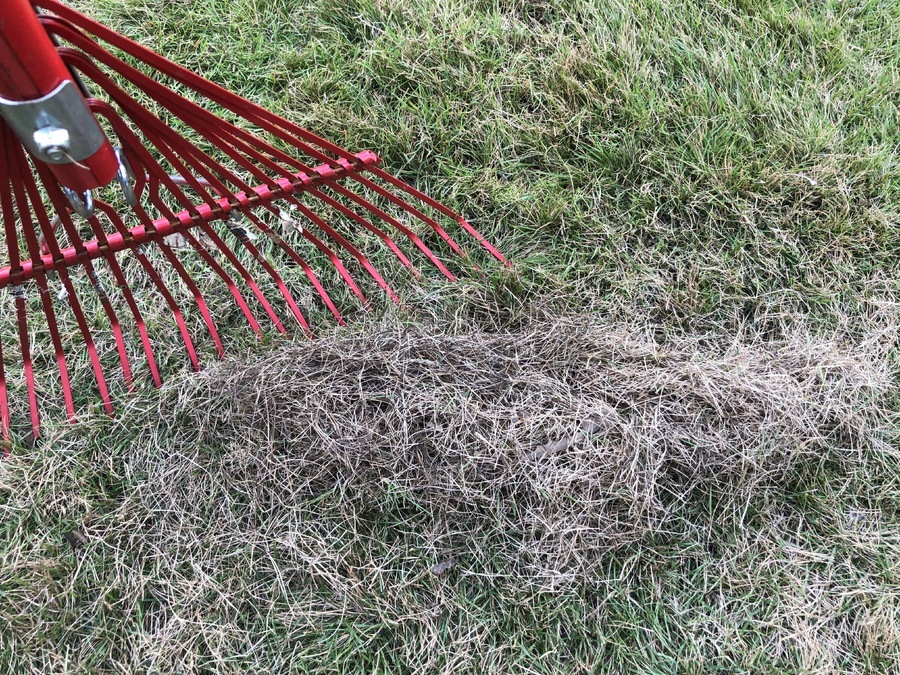
You are now done dethatching. Straightforward, right? Even though it doesn’t take up much time (and raking is good exercise), it’s ideal to prevent thatch accumulation, rather than trying to fix it by yearly dethatching.
Burn to Dethatch - No, Don't Burn Your Lawn!
Time was, folks would torch their dormant warm-season lawns to burn up the thatch. Sod farms used to light up their sod fields too, but this practice was abandoned more than 50 years ago.
Greg Nichols (inside sales rep) warns that, "Dormant grass gets very dry and brittle, so fire moves very quickly." Because fire is the active ingredient, there are big problems with burning turfgrass:
- Fire. We still hear current stories about a person setting fire to their grass/thatch and in the process burning down their neighbors' houses and trees. In fact, most municipalities prohibit this practice because of the obvious risk.
- And Fire. It's impossible to control the temperature, therefore it's impossible to control how aggressively fire burns the intended target: lawn thatch. If too hot, it will kill the stolons and rhizomes, thereby outright destroying your lawn.
Burning lawns is an old fashioned dethatching technique that is replaced by the preventative methods we explained: aerating/compost topdressing, regular mowing and smaller clippings, avoidance of extra amounts of nitrogen, and use of dethatching machines or rakes. To plainly state it again, "don't burn your lawn."
When to Dethatch Warm-Season Lawns
Dethatch warm-season lawns with runners, such as Bermuda, Zoysia, and Centipede, during different times of the year, depending on your method of choice.
Spring & Summer ☀️
- Mowing: Good mowing habits (weekly)
- Aerating: Core aerating and compost topdressing (once a year)
- Scalping: Avoid scalping
- Dethatching: Use a dethatching machine or rake (only if needed)
Autumn 🍂
- Mowing: Continue mowing your lawn until your lawn goes dormant so that your lawn is at it's normal short summer height through winter (keeping it short helps warm-season lawns properly green up in the spring). Dormancy time is climate dependent; for instance in the coastal plain you may be mowing a month later than in the mountains.
- Aerating: Do not core aerate or compost topdress this time of year because it stimulates growth and the unsightly core plugs will drive you crazy all winter long
- Scalping: Do not scalp your lawn in the fall because it won't have time to recover before it goes dormant
- Dethatching: Use a dethatching machine or rake (only if needed)
Late Winter ❄️
- Mowing: No mowing necessary when your lawn is dormant
- Aerating: Core aeration and compost topdressing is technically okay during late winter, just before spring green-up, but the unsightly cores will irritate you. If you can be patient about the cores sitting around on your dormant lawn, they will become less visible when the grass starts growing in the spring.
- Scalping: Scalping is okay before spring green-up, if you must, but this one worries us, as we explained above
- Dethatching: Use a dethatching machine or rake (only if needed)
When to Dethatch Cool-Season Lawns
The cool-season lawn we commonly grow in the Southeast is Tall Fescue. It grows in clumps, rather than by runners and thatch doesn’t build up in this type of lawn.
There’s no need to dethatch them! Those dead grass blades will break down quickly enough and benefit the soil.
Benefits of Dethatching
Now that you’ve gotten a handle on the thatch situation, you’ll experience why your lawn benefits from a reduced thatch layer and you’ll get more satisfaction from it.
- Increase the amount of water and nutrients that reach your lawn’s root system to be taken in; otherwise held up the spongy thatch
- Reduced mushrooms
- Reduced risk of disease
- Aesthetics: a cleaner looking lawn with more living, green foliage and less brown, dead thatch
